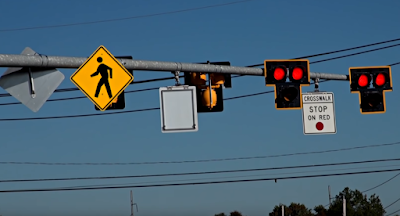Remember Abuelina? She was the animated figure in Montgomery County’s public health campaigns during the COVID-19 pandemic. Her comforting guidance was credited with boosting vaccination rates among the Maryland county’s Spanish-speaking population.
She’s back and this time, Abuelina is helping Spanish-speaking pedestrians navigate traffic signals, called HAWK lights or pedestrian hybrid beacons. These activate only when a pedestrian pushes a button.
But Wade Holland, Montgomery County’s Vision Zero coordinator, said Wednesday that the signals can be a bit confusing.
He broke down how the signals work and explained what drivers should do when approaching them.

When the lights, with two up top and one at the bottom, are dark, drivers can proceed.
“Obviously, you want to check the crosswalks and make sure no one’s crossing even when the lights are off,” Holland said.
Assuming a pedestrian has hit the button, the bottom light will turn yellow.
“When it’s yellow, same as a traffic signal, get ready to stop,” he said. Then, the top two lights will turn solid red.
“As long as it’s a solid red, you’re not allowed as a driver to go through until that has gone completely inactive or dark again.”
Montgomery County currently has 20 PHBs installed throughout, and Holland said 20 more are in the pipeline.
The devices are not unique to Montgomery County. D.C. also has the signals, but Holland said they operate slightly differently.
If you’re in D.C., there’s a second phase in the red light sequence. It will go solid red, and drivers have to stop.
Then, the red lights will flash and, “You can kind of treat it like a stop sign at that point,” Holland said.








